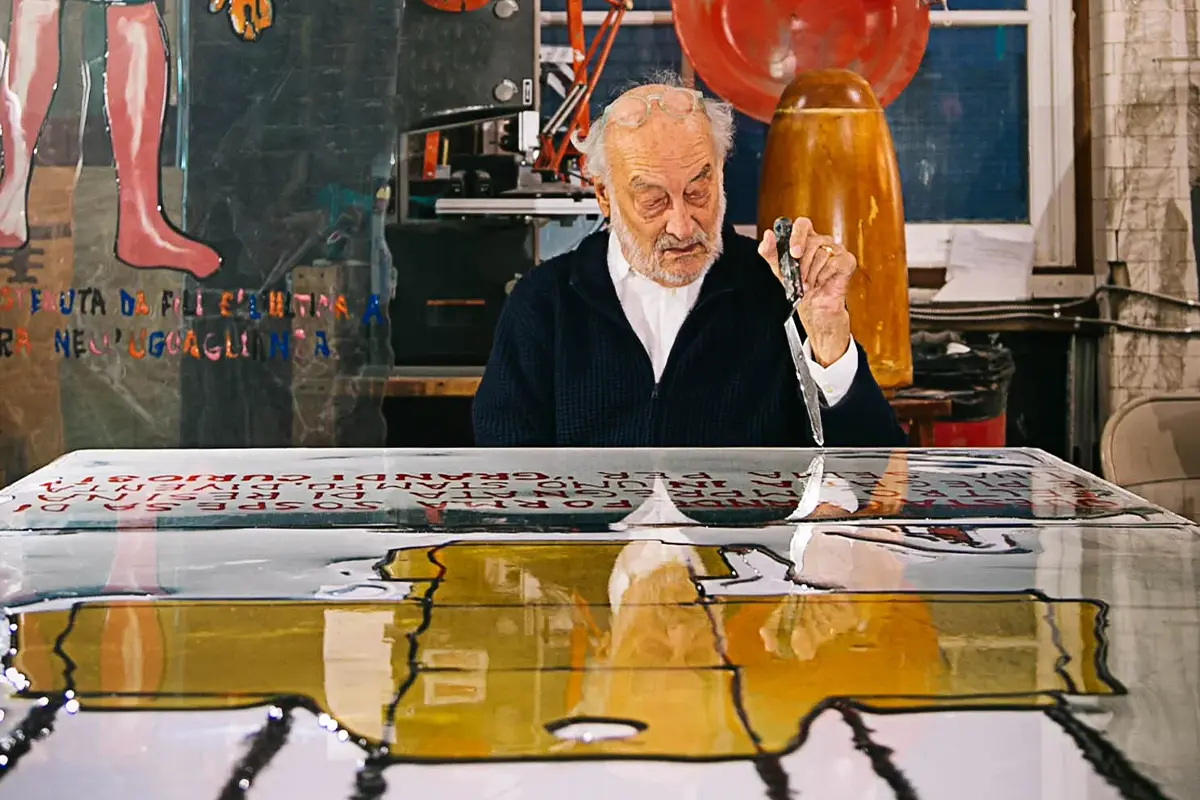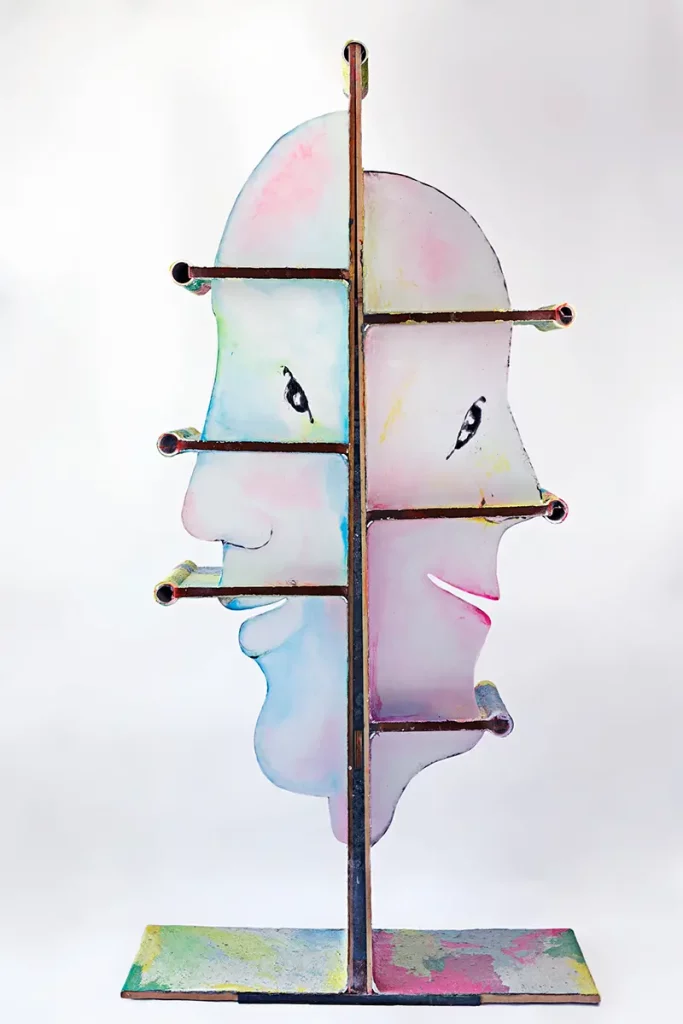From the polyurethane of the UP series to the resins of Vieni a Vedere installation for Bottega Veneta: experimentation doesn’t need to be taught; it just has to be done
Vieni a Vedere (In Italian ‘Come to see’). This is how Gaetano Pesce invited visitors at the Milan Design Week 2023 to discover My Dear Mountains and My Dear Prairies, the two limited and numbered edition bags made for Bottega Veneta. The two creations were set up inside a cave, made of resin and fabric, at the end of a twisted path: an invitation to exploration.
Gaetano Pesce is breaking rules
It is difficult to define what Gaetano Pesce is or does. His creations – whether design, art or architecture – are driven by a single rule: to innovate. Of Ligurian descent, he graduated from the University Institute of Architecture (IUAV) in Venice in 1965.
Of his student years he tells: «I had no Masters. Actually, yes, one: Bruno Zevi. At the time, I was nineteen years old and he was like a volcano, teaching us to disregard the rules, the opposite of what is usually taught in school. He was trying to awaken us from our slumber. We continued to be friends even after I graduated, and every time I was in Rome I used to visit him in his office in Via Nomentana, but I had the feeling that he had resentment toward me, because he thought I wasn’t doing enough. For me, those were brooding years. My masters, even at that time, were called Michelangelo, Leonardo, Brunelleschi, Caravaggio, Raffaello. They are Masters to me because I do not take into account their time, but their attitude: they taught me that you make art by looking forward and discovering. I do not follow their forms, but their approach, which I apply to my own time».
Gaetano Pesce – I try to avoid congruence
Gaetano Pesce chases thoughts without pausing and tells: «I try to understand the time in which we live, a time that moves faster than in the past, changes values and is contradictory. When I was younger, I had an extraordinary and intelligent partner, Milena Vettore, who helped me understand what my role in the world was supposed to be. With her I realized that my behavior should have been driven by inconsistency.
Our time is incoherent, full of information that makes it impossible to have a logic or direction. Our time makes us think one way today but maybe the opposite way tomorrow. Our willingness to be linear can only disappear and we become liquid, like our time.
That’s why I get tired easily of what I do and I don’t want to review the next day what I accomplished the day before, because I don’t want it to make me bored. I need to experiment and be happy with what I do. If I find myself having to repeat, having to reflect on a past thing, I get depressed. I try to avoid this kind of congruence».
No one should have any barriers today according to Gaetano Pesce
In 1959 Gaetano Pesce founded in Padua, with Milena Vettore, the “N” Group, a ‘collective’ of architects and artists focus on, as stated in the programmatic text drafted in 1961 ‘the need to collectively research’: «Milena passed away very early, in eleven days, due to a stroke, while we were doing researches commissioned by Cassina company. She taught me a lot and especially not to be attached to anything. This is who I am today: if yesterday I thought my art should not be recognizable, today I don’t know if I think that anymore.
If yesterday I thought that the greatest value of our time was diversity, I don’t know if I still believe that today. I look for the meaning of living, I do this with my work: I have no limits and I don’t think anyone should have any. We have to express ourselves according to what time suggests. Time is a great teacher, perhaps a god, we owe it everything».
‘The New Domestic Landscape,’ the MoMA New York exhibition
In 1972 some of his works were included in ‘The New Domestic Landscape,’ the MoMA New York exhibition that made Italian design famous worldwide. In 1996 the Centre Pompidou in Paris dedicated a monographic exhibition to the designer: Gaetano Pesce Le temps des questions. Over the years, Gaetano Pesce has lived in Venice, London, Helsinki, and Paris. He has taught in Strasbourg, France, Pittsburgh, Hong Kong, São Paulo, and New York.
«I have always been working, but only recently the world woke up and discovered how much I had accumulated in my past, what I had already been producing for fifty or sixty years. In 1969 I designed a work that I still believe in very much: the UP5 armchair, shaped as a woman with a ‘ball and chain.’ A representation of her being a prisoner and victim of male prejudices and fears and stupidity. I believe, a few years later, that things are getting better: more and more often we hear about women in leadership roles in companies, organizations or countries, even in Europe and Italy. That project tells that an object can send political messages and that figuration helps to be more explicit, it allows others to understand. The beginning of my path was not understood, because innovation always has a delay in its understanding».
Would Italians know how to make the Tower of Pisa today?
The contradiction is spontaneous in Gaetano Pesce: his father is from Florence and his mother from Venice. Both cities of art have taught the architect the complexity: «In Venice, I learned that color and light in designing are more important than drawing. In Florence I learned the opposite, that drawing is the most important element. Italy has made architectural and artistic works that are copied by the whole world, since forever, but today maybe we are no longer capable of doing that.
The question is, would Italians today be able to imagine the Tower of Pisa? Would they be able to make the Colosseum, Antonellian tower or Pantheon? Would they be able to build a city on water? Today Italy suffers from a lack of energy, Italy has lost its prestige in the 21st century».
2011, ‘The Italian Crucifixion’ – Italy is being crucified
In Milan in 2011, the architect set up ‘The Italian Crucifixion’ and depicted the Italian peninsula dripping with blood, nailed to a seven-meter-high crucifix.
More than twelve years have passed since then, and not much has changed: «Italian prestige no longer exists, except for food, fashion and design. The Italian Republic President should say that. We should shake ourselves up and roll up our sleeves, become creative again as we were in the past. Instead, the Strait of Messina Bridge project resembles San Francisco’s Golden Gate Bridge. Italy has bridges that no other country in the world has, such as the inhabited ones in Florence, in Rialto. We should make an inhabited bridge, not an imbecile bridge that only allows you to go from one region to another. A structure that allows people to tell and discover the reality of our country».
Gaetano Pesce: Architecture is as useless as philosophy
Gaetano Pesce’s works convey cheerfulness, lightness and joy: «If I look at the sofa Sunset in New York, I understand that there is a message behind it, of the possible decay of a place, which has not happened. There is a sun, which could have been a sunset, but it is a sunrise».
Exploration with design scales does not scare him, from the spoon to the city, from design to urban planning: «Where do I learn? Leonardo was curious, Raffaello was curious as well, the great ones are curious. I am driven by my curiosity to find out what is missing around us. From a certain point of view, architecture does not really benefit anyone, it is like philosophy: it is not useful if someone does not want to think. But architecture, like philosophy, helps us understand our time because in order to age, we need music, poetry and art in general, which stimulates our brains, and helps us experience».
Gaetano Pesce: Experimentation doesn’t have to be taught, it just has to be done
As early as the late 1960s, Gaetano Pesce declared that designer, rather than a creator, must be a discoverer of the new meanings of this time. Since 1980, Gaetano Pesce has chosen New York to do that: «Things happen here sooner than anywhere else and for this reason our time is more recognizable here than anywhere else. It is a city full of minorities, energies and effervescence, and people invest in new ideas. I came here because it was the first city that gave me the economic possibilities to live: I sold my first drawings, to Barbara Jacobson, for the Museum of Modern Art. New York is hungry for innovation.
In our studio in Brooklyn, we work disorderly, but this is how research works. There are eight or nine of us and we do everything, because creativity has no limits, there is no limit to our expression. Experimentation doesn’t have to be taught; it just has to be done. Being multidisciplinary is a must, otherwise you are a quitter».
From the polyurethane of the UP-seating collection designed since 1969 to the resin of the four hundred seats in the ‘How are you?’ series presented at Bottega Veneta’s Summer ’23 fashion show, the architect continues to experiment, trying out every new technology. On artificial intelligence, he wonders diffidently: «I wonder if it has the capacity to draw on the immense reservoir of our notions and repurpose them what is not required, as our brains do. Artificial intelligence is fine only if it is functional».
Gaetano Pesce
Born in 1939 in the town of La Spezia, Northern Italy, Gaetano Pesce studied architecture at the IUAV in Venice and attended the Institute of Industrial Design in Venice, an experimental school where he met Milena Vettore, with whom he opened a studio in Padua, founding the “N” group in 1959, which deals with studies on programmed art. He carries out research in the field of kinetic and serial art. In 1983 he moved to New York, where he lives and works. His works can be found in the world’s major design museums.




















